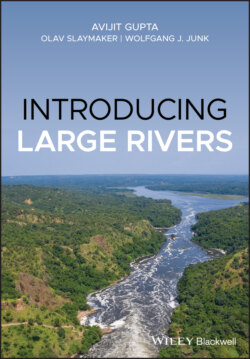Читать книгу Introducing Large Rivers - Avijit Gupta - Страница 30
4 Morphology of Large Rivers 4.1 Introduction
ОглавлениеWhat are the characteristics of a large river? Meade (2007) has described large rivers as ‘massive convenience systems for moving detrital sediment and dissolved matter across transcontinental distances’. This implies a very long river, say 1000 km or longer, that carries a huge volume of water and a large sediment load of several types from the land to the sea.
Many smaller rivers have been studied in detail but only a limited number of large rivers. The biggest, the Amazon, has been observed in detail (Junk 1997; Dunne et al. 1998; Mertes and Dunne 2007), and also several others, particularly the Mississippi (Knox 2007 and references therein). Detailed morphological descriptions and relevant hydrologic and sedimentological data, however, are not available for all. We know a lot less about certain rivers such as the Congo or Salween.
This raises several questions. Is there a continuum among rivers of different size, i.e. does a scale invariance in form and behaviour exist between small and large rivers or do large rivers have special properties? Do large rivers, immense in form and complicated in function, record evidence of crustal deformation, hard rock erosion, and water and sediment fluxes over long time periods, as Mertes and Dunne (2007) have shown for the Amazon, which could not be studied in smaller streams? Does the presence of a large river imply a geological history and a climatic condition as described in Chapters 2 and 3 of this book? Do large rivers last longer than streams of smaller dimensions? Do the effects of sea-level changes remain recorded in detail over a long stretch of the lower section of a continental-scale river because the gradient is very low? Do floods and floodplains play an important role regarding the morphology and ecology of large river valleys? Can huge sedimentary alluvial deposits/bars of large rivers such as the Brahmaputra (Figure 4.1) be recognised in later sedimentary rocks (Fielding accepted for publication)? In this chapter we explore these and other queries, and describe the general morphology and behaviour of big rivers.
